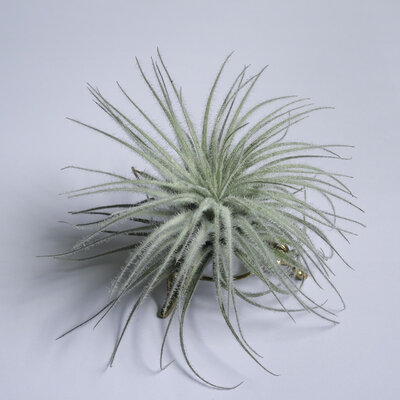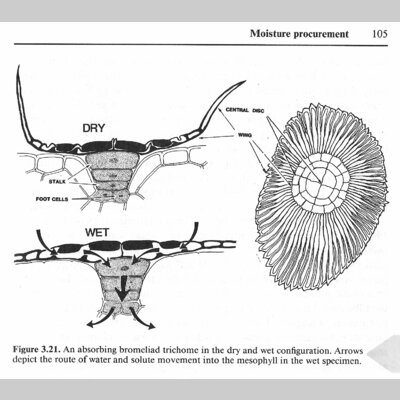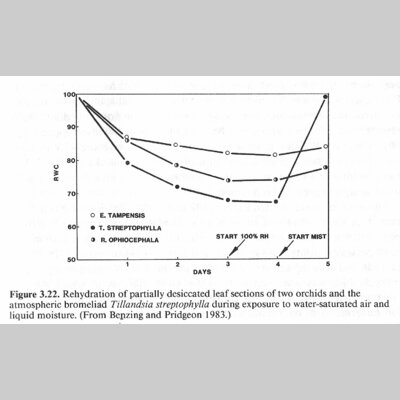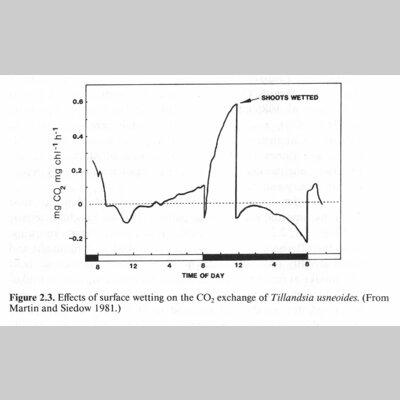tillandsia cultivation, pt. 1: experiment proposal
2019/07/27
I happen to like plants, but not dirt, and eventually stumbled upon the perfect solution: Tillandsia. However, I worry about making sure their growing conditions are ideal, and after a review of the literature I've come to some conclusions, which I intend to examine with a little experiment.
airplants: background
Members of the genus Tillandsia are popularly described as "airplants" because most of them grow epiphytically, without direct access to soil or groundwater. Of course, they're still plants, so they actually need air, water, sunlight, and fertilizer. In the natural environment, air is easy, since they grow on the upper branches of trees (or other similarly exposed areas). Water is from rainfall or heavy morning fog. Sunlight is usually moderated by leaf cover from the host plant. Primary (N, P, K) and micro nutrients (most critically Mg) will be recieved via rainfall and dust accumulation, with the exact details varying by species and environment.
One neat feature of these plants is the trichrome, a structure that can both deflect excess light during dry spells and convey water into the plant when wet. As a rule of thumb, more trichromes means a more arid native environment.
If something is not specifically cited here, it's from Benzing's Vascular Epiphytes (like the image above), which was a fun read and a nice overview.
indoor cultivation
These plants grow at a very slow pace, especially indoors, so it can be hard to tell if they're happy with their environment (growth rates are around 5 milligrams of growth per gram of plant per day under ideal conditions [2]). Popular advice is partial sun, fertilize monthly, and water via soaking once a week. The length of time soaked, how to dry the plants to avoid rot, what types of water to use, what types of fertilizer, if the plants can survive purely via sprayed water, if supplementary water is required more often, are all, in my opinion, poorly examined on the web. No sites I looked provided any sort of source or supporting evidence for any claims about correct growing conditions.
Water is probably the first thing that will kill an airplant, either via underwatering or overwatering, so this first blog post will focus here: When should we water, how much should we water, how should we water?
the experiment
How can we tell if a plant is getting watered enough? I found this great graph of Tillandsia water uptake [1].
The plant was not watered for four days, losing 30% of its water content, and then fully restored via misting water on it. Some Tillandsia can even survive losing 80% of their water [2]. Water is a large part of the plant's entire weight, so we can estimate water content just by weighing it! There's no dirt to confound the measurement, and growth is negligible over a week, so most change will be water. I considered buying a dozen plants and doing a double-blind randomized trial with different watering schemes, along with finally applying some of my stats education, but I'm not trying to pass peer review here, so let's take a simpler approach:
Iterate over these three strategies:
- Water by soaking for half an hour once each week (i.e. soak once and nothing more for a week)
- Water by misting each morning and also soaking for half an hour each week (soak once and mist every day for a week)
- Water by misting each morning (no soak, and mist every day for a week)
Misting will be defined as "spray water until the plant is covered and a small amount of water runs off."
Every evening, weigh each plant, and then graph it. Data analysis will consist of... looking at the graphs. I strongly suspect the differences will be trivially obvious. If they aren't, then I'll consider that evidence in support of watering however I want.
other factors
Tillandsia are mostly CAM plants [1]. If you don't know what this means, Wikipedia can give you the rundown, but we don't really care about the details, just the implications for plant care. There's one which I think is particularly relevant: response to water.
This graph shows how water at night halts respiration, which I believe will seriously impair growth [1]. Water in the morning!
Water quality is a difficult topic; it may have a weird pH, mineral content, metals, chlorine, or other contaminants, all of which can harm a plant. Popular advice is to use rain water, pond water, or failing that, bottled water. We cannot use water completely devoid of ions, which will leach micronutrients out of the plant, killing it in a month or two [1]. Of course, for large numbers of plants, tap water is used (I would be curious to hear from commercial producers). I will be using bottled water with a little aquarium water mixed in. In the future I hope to send tap water samples for lab testing, which turns out to be a service used by the home brewing community, and is relatively cheap/available. Correct nutrient levels, and fertilization, will be a future blog post, along with optimal light levels.
For the moment, let it suffice to say that I use Air Plant Hub's house fertilizer, misted heavily once every other week, and my plants are kept in a south-facing window with peak light around 50k lux.
links
- TrekGeo Tillandsia database: growth logs of hundreds of Tillandsia, along with watering method and commentary
- Air Plant Hub is a Tillandsia supplier I've been quite happy with
references
[1] Benzing, David. Vascular epiphytes: general biology and related biota. Cambridge University Press, 1990.
[2] Zotz, Gerhard. Plants on Plants: The Biology of Vascular Epiphytes. Springer, 2016.



